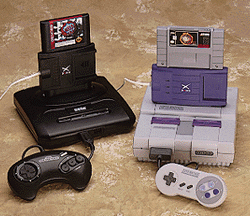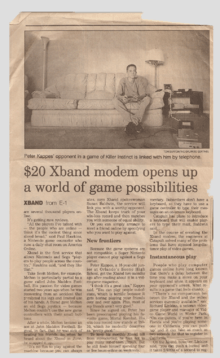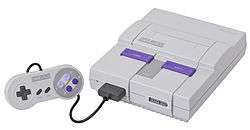XBAND
XBAND (stylized as XB∀ND) was the first online console gaming network, and was available for Super NES and Genesis systems. It was produced by Catapult Entertainment, a Cupertino, California-based software company. It is the only modem released in America to have been officially licensed by Nintendo.[1][2][3] It debuted in various areas of the United States in late 1994 and 1995. Online console gaming networks were eventually stabilized in the sixth and later generations of video games, such as Xbox Live, PlayStation Network, and Nintendo Network.
History
The Genesis version of the XBAND was released in November 1994,[4] with the Super NES version following in June 1995.[5]
In 1995, Catapult Entertainment signed a deal with General Instrument, producers of the Sega Channel, which stipulated that the XBand modem would henceforth be built into new Sega Channel adapters, and that the top 5 to 10 games offered by Sega Channel each month would be wired for play over XBand.[6]
Initially, Catapult Entertainment had a limited staff and virtually no advertising. By January 1996, XBAND network playability had reached practically every metropolitan area and several rural areas in the U.S. The actual XBAND modems were carried by a handful of software and video rental chains across the United States. Internationally, the XBAND saw some limited expansion in the Japanese market, and Catapult was working on PC- and Sega Saturn-based versions of the platform, though they were acquired by Mpath Interactive, and the focus shifted to the online PC gaming service, Mplayer.com.
Service

The concept of playing online was fairly new at the time. Arcades were still quite popular, and online gaming was not yet a household idea.
The XBAND modem was widely available at Blockbuster Video branches during its time. It retailed for $19.99, with additional charges based on usage.[7] Two pricing plans were available. One had a monthly fee of $4.95 and allowed the user to connect to the service up to 50 times a month with each additional connection costing 15 cents. The other had a monthly fee of $9.95 and granted the subscriber an unlimited number of connections per month.[8] Activities that consumed a player's monthly allowance of connections included dialing in to the XBAND service for matchmaking, downloading mail (called "XMAIL"), and downloading the daily edition of the two XBAND newsletters, one containing generic news and the other containing platform-specific information such as leaderboards and contest announcements. Players were also assessed a fee of $3.95/hour for connecting to opponents outside their local calling area;[9] player-to-player connections inside their local calling area were free.
The modem features built-in storage for up to four users ("codenames"). It stores user friend lists, which can contain the codenames of up to ten of the user's friends; the users' XMAIL boxes, storing up to ten incoming and ten outgoing messages for each user; the users' rankings, win/loss records, and accumulated scores; a short profile section; and the user's avatar (chosen from 40 preset avatars). Text entry is done either through an on-screen keyboard or an optional XBAND keyboard add-on released later in the network's lifespan.[8]
The client-side system worked by manipulating the game's memory in a way similar to Game Genie and third-party computer game modifications such as Multi Theft Auto.[10]
A problem of most online services of the time was that the connection would be lost whenever a phone on the same line was picked up. The XBand operating system was designed to ensure that connections are not lost due to phone activity; in the case of call waiting, the system would alert the user to the call and allow the game to be resumed.[11]
XBAND had an official website where a member could check any other player's statistics, along with other information and updates that were not available to view on consoles.
At its height, XBAND had 15,000 subscribed members.

Gaming
A 1995 article in Next Generation stated that the XBAND modem's "ultra-low latency is the key to its successful handling of realtime videogaming".[7] The modem's data transfer rate was 2,400 bits per second, which, while low compared to PC modems of the time, was sufficient to handle the simple one-on-one games which XBAND was used with.[8]
When connecting to play, unless a player specified a particular user from their friend list, players would be matched with a random player elsewhere in the country (or the player's local area code depending on their preference settings) who was also connecting to play the same game. When the network matched two players up, one player's telephone would ring once and the XBAND modem would answer. At that point the players would see the XBAND logo slide together, followed by the matchup screen, which displayed each player's codenames, avatars, locations, and a pre-typed "taunt".
In December 1995 XBAND launched its first national tournament. This is the first modem to modem tournament ever to be held over a console. The grand prize winner received a special Genghis Khan icon for their XBAND profile and a $200 cash prize from Catapult. Peter Kappes aka "SphiNX" of Orlando, FL became the first person in history to win a modem to modem national tournament over a console.
Icon hacking
During the last few months of service, several users discovered a way to use a Game Genie to hack the icons of XBAND players. This enabled players to use icons that were otherwise restricted, such as unreleased icons or icons reserved for matches between XBAND team members. Icon hacking resulted in complaints from other users. Rumors about XBAND icon hackers often claimed they were part of elite hacking organizations or members of Catapult Entertainment. Eventually, the method used by the hackers was leaked and inevitably spread throughout the community.
Demise
By March 16, 1997, people could only play within their local area code. On April 30, 1997, the entire network was removed.
XBAND had announced in their previous monthly newsletter that they were shutting down, with the newsletter writers citing the service's lack of popularity as the cause. During XBAND's existence, only a handful of advertisements were ever made, and only one game, Weaponlord, had the XBAND logo on its box. XBAND stated in their newsletter that players were their best form of advertising, and offered the "XBAND 6 pack", where members could order six modems at a discounted rate and receive a month of free gaming in exchange for signing up a certain number of people to the service.
Heavy contributors to XBAND's demise were the lack of support from game developers and limited internal resources. With the exception of Weaponlord, Catapult had to individually reverse engineer each game's code, then develop a hack to intercept two-player activity so the game could be shared over a low-latency (fast response time), 1200-baud modem connection.[12]
Catapult's second generation attempts were blocked by the hardware manufacturers. The XBAND was tested in Japan (using a 14,400 baud modem) for a short time for the Sega Saturn, but met competition from Sega's own Sega NetLink service, which also used XBAND technology. An expansion into the PC market didn't pan out either, as developers frequently opted to include their own network linking rather than deal with Catapult's subscription-based service.
Service issues
A major issue for the XBAND service was free long-distance phone calls. It was discovered that a user could record the tones sent from an XBAND modem and then receive the long-distance service number, the authentication code, and phone number of the player you were connecting to. This information allowed anyone to access long-distance phone calls that were charged to Catapult.
Paging company SkyTel faced similar problems from both XBAND users and their own customers. XBAND users performed brute-force attacks against SkyTel's mobile paging system in order to discover voicemail boxes using the same number as the login and password, using these to extend their communication with each other. Most messages consisted simply of shout-outs with music playing in the background.
A common complaint was that if a player was losing a match, they could simply pull their phone cord out or turn off their system. This tactic, known as "plug-pulling" among XBAND users, prevented the XBAND service from crediting either player with the win or loss. In response to complaints, the company was unable to develop a means to detect such forced disconnections.
Catapult was also unable to prevent harassment; there were no filters or privacy controls to prevent vulgar language and obscene mail.[13]
Publishing statistics
Despite poor marketing success, the XBAND team did manage some publicity gains when they joined forces with a number of gaming magazines, starting on the web with Game Zero magazine and later in Tips & Tricks Magazine. Daily stats were accessible via 'XBAND News' on the modem, although they were not visible to the general public. Publishing stats added a "cool" factor to brag about in the early forefronts of online gaming. The top-ranked gamers of the previous month were published starting in January 1996 in Game Zero and, starting in early 1996, in Tips & Tricks magazine as well.
Supported games
The following games have been analyzed, and online compatibility provided, by XBAND.[1]
|
|
(Japan XBAND branded releases only)
|
See also
- GameLine, a third party dialup service for the Atari 2600
- Famicom Modem
- Intellivision's PlayCable
- Teleplay Modem, a third party modem made for the NES, Super NES, and Genesis
- Sega Genesis's Sega Channel
- Sega Meganet - Sega's own online gaming service for the Mega Drive
- Satellaview - A satellite modem for the Super Famicom with non-interactive online gaming
- Sega NetLink - Sega's Online service for the Sega Saturn
- 64DD Nintendo's 64DD and Randnet online service of 1999-2001 in Japan
References
- 1 2 "Snes Central: X-Band". Retrieved March 7, 2015.
- ↑ "Lost Levels - A website about unreleased video games.". Retrieved March 7, 2015.
- ↑ "Gadgets from the ads of the past – Teleplay System by Baton". World 1-1. Retrieved March 7, 2015.
- ↑ "The Joy of X". GamePro. IDG (66): 188. January 1995.
- ↑ "XBAND Goes Nintendo". Electronic Gaming Monthly. Ziff Davis (72): 27. July 1995.
- ↑ "Sega Channel, XBand Merge". GamePro. IDG (83): 116. August 1995.
- 1 2 "75 Power Players: Connected". Next Generation. Imagine Media (11): 75. November 1995.
- 1 2 3 Yee, Bernard (January 1996). "Joyriding". Next Generation. Imagine Media (13): 27.
- ↑ "SNES XBand Arrives". GamePro. IDG (82): 131. July 1995.
- ↑ Ashley, David (October 25, 2010). "Some XBAND Recollections". Archived from the original on May 10, 2013. Retrieved August 25, 2011.
- 1 2 3 4 5 6 7 "XBand Is Playing". GamePro. IDG (67): 18. February 1995.
- ↑ dashxdr. "David Ashley". Archived from the original on May 10, 2013. Retrieved March 7, 2015.
- ↑ McFadden, Andy. "Handling Unsportsmanlike Conduct Online". Retrieved February 17, 2012.
External links
- XBAND - Official Website (ARCHIVED)
- Xband (fan) facebook page
- Some archived pages of Catapult's "XBAND XClusive" on GameZero.com
- A write-up of the service from Sega-16
- Gamer's Graveyard Article
- Handling Unsportsmanlike Conduct Online by Andy McFadden — XBAND is an example
- Popular "Blog of the Day" entry on 1up.com about one gamer's look back on his XBand obsession

